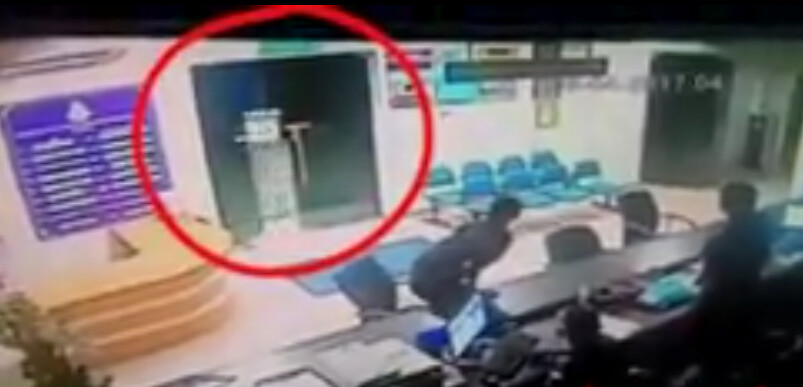Image: The relic at display
Image: Relic close-up
Image 2: Relic close up
The flesh and blood of
Christ is still being preserved in the church of San Francesco in Piazza
Plebiscito at Lanciano, Italy. It all started in 750 AD, when a Basilian monk
while celebrating the holy mass at St. Legontian Church at Lanciano. The monk
started to have doubts on the real presence of Jesus Christ in the consecrated
holy species. As soon as he pronounced the words of “consecration” (this is my
body, this is my blood), the monk witnessed the host changed into a living
piece of flesh and the wine turn into real blood.
Image: Church of San Francesco in Piazza
Plebiscito
Analysis of the specimen
– by Dr. Edoardo Linoli
A brief biography of
Dr. Edoardo Linoli
Dr. Edoardo Linoli is
a professor of anatomy and pathological histology, chemical & clinical
microscopy, and former head of the Laboratory of Pathological Anatomy at the
Hospital of Arezzo. He was the only doctor who analyzed the relics from the
miracle of Lanciano.
Authorization from
church officials to have the relics examined scientifically
In November 1970, the
archbishop of Pacifico Perantoni of Lanciano, the provincial minister of the
Franciscan Conventuals of Abruzzo with the authorization of Rome mooted an
initiative to have the relics examined scientifically.
Linoli and his
assistant analyzed and concluded their findings.
Linoli was assisted by
Dr. Rugerro Bertelli, also a retired professor of human anatomy at the
University of Sienna. The analysis work covered on the relic, the miraculous
flesh and blood were extracted with great care by Linoli and made the analysis.
He presented his findings on March 4, 1971.
The following are
his findings:
The flesh is real
flesh, the blood is real blood. The flesh consists of the muscular tissue of
the heart (myocardium). The flesh belongs to the human species. The flesh and
blood have the same blood type which is AB. In the blood, there were traces of
proteins in the same normal proportions as found in the sero-proteic make up of
flesh and normal blood. There were also traces of minerals found in this blood
such as Chlorides, Phosphorus, Magnesium, Potassium, Sodium and Calcium.
The relic sample
matches with the man from the Holy Shroud of Turin
In the interview with
Zenit, Linoli further explained,”as regards to the flesh, I had in my hand the
endocardium. Therefore, there is no doubt at all that it is cardiac tissue.” In
regards to the blood, “the blood group is the same as that of the man of the
Holy Shroud of Turin, and it is particular because it has the characteristics
of a man who was born and lived in the Middle East regions. The AB blood group
of the inhabitants of the area in fact has a percentage that extends from
0.5-1.0% while in Palestine and the region of the Middle East; it is 14-15%”
He says, “Though it is
alien to my task, strictly speaking, I feel that I should insert the following
reflection into the study just completed: the classification which comes
through in these studies, of the nature of flesh gives little support to the
hypothesis of a “fraud” perpetrated centuries ago. As a matter of fact,
supposing that heart may have been taken from a cadaver, I maintain that only a
hand experienced in anatomic dissection would have been able to obtain from a
hollow internal organ such a uniform cut as can still be glimpsed in the flesh.
Another characteristic
property of the blood sample was that when liquefied, it has retained the
chemical properties of freshly shed blood. Usually, when we cut ourselves and
stain our clothes with blood, the chemical properties of our blood is gone
within 20 to 30 minutes. If blood is not refrigerated within an hour, the
composition will rapidly break down. If blood was taken from a dead body, it
will lose its qualities quickly through decay. The blood sample analyzed by Dr.
Linoli is believed to be over 12 000 yrs old. It still contains all its
properties, chemicals and proteins of freshly shed blood. It was further
testified that were no preservatives found in the blood.
World Health
Organisation appoints commission to verify Linoli’s claims
In 1971, his report
was published in "Quaderni Sclavo di Diagnostica
Clinica e di Laboratori". Following this, in 1973, World Health
Organisation appointed a scientific commission to verify Linoli’s report. The
task consisted of 500 types of examination which took 1 year 3 months to
complete. The conclusion of these tests does not vary with Linoli’s findings.
As a result, in 1976, the extract of scientific research of WHO’s medical
commission was published in New York and Geneva that confirmed that science was
unable to explain this phenomenon.
CONTRIBUTION:
Zenit.org








1 comment:
Hi Sudheer,
Thank you. Will do. Thanks for dropping by.
Post a Comment